The most precise tools for measuring microscope specimen light angles include goniometric measuring heads (accurate to 0.1 degrees), digital protractors with user-friendly interfaces, and telecentric lens systems that eliminate distortion. You’ll also find specialized stage mounts, angle measurement software for real-time analysis, and advanced illumination systems with angular control capabilities. For challenging specimens, consider multi-angle LED illumination options or goniometric attachments that integrate directly with your microscope. The right measurement tool greatly enhances your specimen’s contrast, resolution, and data reliability.
NUMERIC LIST OF 11 SECOND-LEVEL HEADING(S)
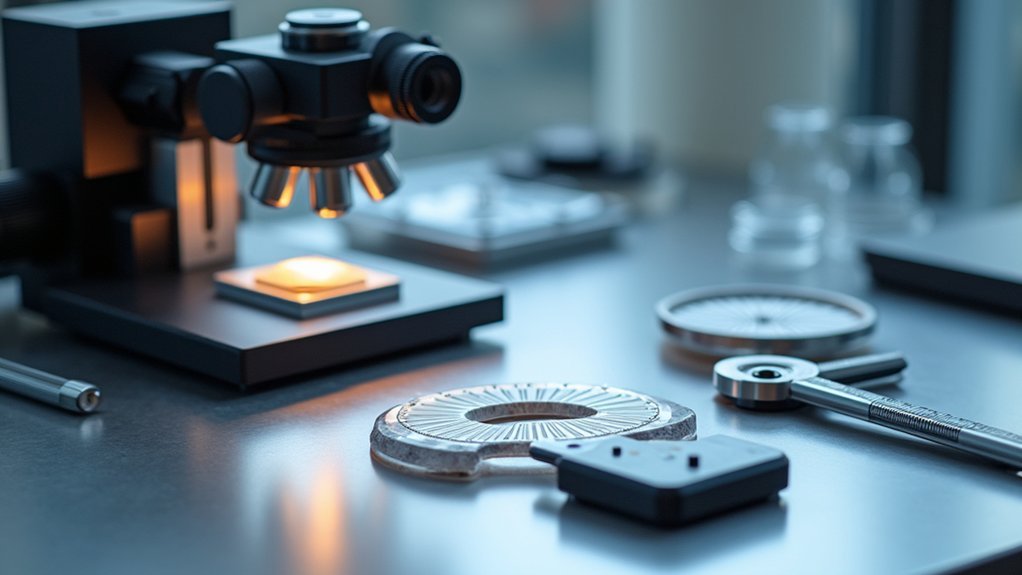
Microscopy enthusiasts and laboratory technicians need specific tools to achieve accurate light angle measurements. When working with your measuring microscope, you’ll want equipment that delivers high accuracy while remaining user-friendly.
Precise angle measurement in microscopy demands tools that balance exceptional accuracy with intuitive operation.
- Goniometric Measuring Heads
- Digital Protractors
- Telecentric Lens Systems
- Angle Measurement Software
- Specialized Stage Mounts
- Adjustable Illumination Controls
- Calibrated Angular Scales
- Image Analysis Applications
- Precision Alignment Fixtures
- Light Path Angle Indicators
- Optical Axis Measurement Tools
Each of these tools serves a specific purpose in your microscopy workflow, helping you achieve precise light angle measurements.
Understanding the Importance of Light Angle Measurements in Microscopy
Precision in illumination serves as the foundation for revealing a specimen’s true nature under microscopic examination. When you adjust light angles in optical microscopy, you directly influence image contrast and resolution, especially in techniques like dark field microscopy. These adjustments help minimize aberrations such as glare and shadows that might obscure critical details.
For transparent or unstained samples, proper light angle manipulation maximizes specimen visibility by optimizing light interaction with the material.
In polarized light microscopy, measuring these angles becomes essential for analyzing anisotropic materials, as the orientation of light reveals structural properties and defects. Using tools like goniometric heads enables you to achieve consistent, precise measurements across different observations, markedly enhancing data reliability in your microscopic investigations.
Goniometers: Precision Instruments for Angle Measurement
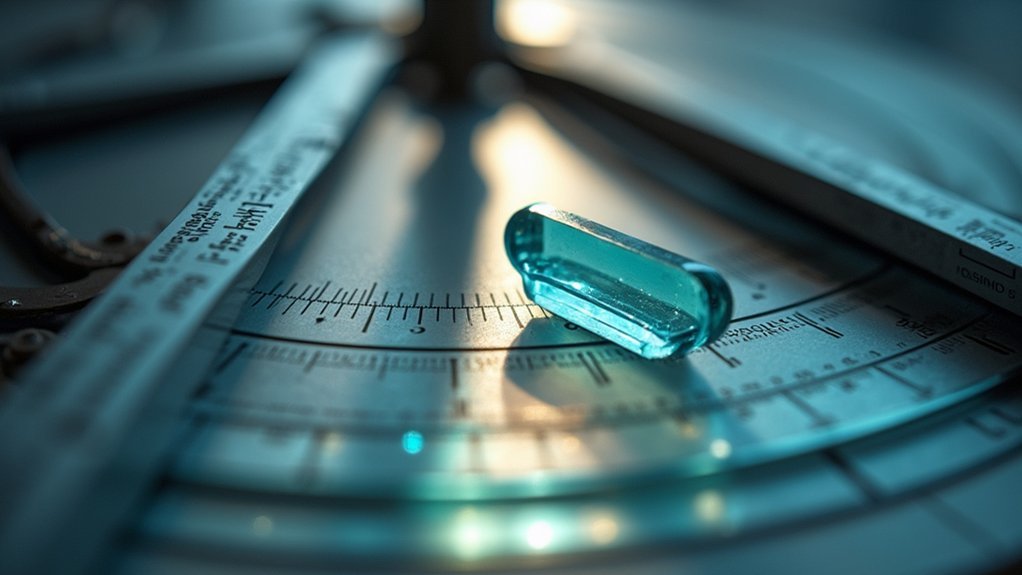
When seeking the most reliable angular measurements in microscopy, goniometers stand at the forefront of precision instrumentation. These specialized tools deliver exceptional accuracy, often achieving precision levels of 0.1 degrees, which you’ll find invaluable for detailed specimen analysis.
You can integrate goniometers directly into your microscope setup or use them as standalone devices, providing flexibility across various scientific applications. Their adjustable stages allow you to position specimens perfectly without compromising sample integrity.
For enhanced workflow efficiency, consider digital goniometers with automated data recording capabilities. These advanced precision instruments streamline your measurement process while maintaining exceptional accuracy.
Whether you’re examining material structures or biological samples, goniometers provide the reliable angle measurement capabilities essential for rigorous scientific investigation and quality control procedures.
Digital Angle Measurement Software Solutions
Digital angle measurement software offers you powerful calibration features that adjust to your specific microscope setup, ensuring measurements remain consistent across different magnifications.
You’ll find these tools can process angular data in real-time, allowing immediate analysis while observing your specimen under the microscope.
The integrated analysis capabilities let you track changes over time, compare multiple measurements simultaneously, and export precise angle data for further research applications.
Advanced Calibration Software
Modern research laboratories rely heavily on advanced calibration software to achieve unprecedented precision in microscopic angle measurements.
These sophisticated tools elevate measurement accuracy and reliability by precisely quantifying angles in microscopic specimens.
You’ll benefit from automated calibration processes that eliminate user error and guarantee consistent results across multiple measurements.
The software integrates seamlessly with high-resolution microscope cameras, enabling real-time angle analysis and visualization.
What sets these solutions apart are their advanced algorithms that compensate for optical distortions in complex specimens.
Even if you’re new to digital measurement, you won’t struggle with implementation—most packages feature intuitive interfaces and thorough tutorials.
Whether you’re analyzing crystalline structures or cellular orientations, advanced calibration software delivers the precision your research demands.
Real-time Measurement Analysis
As research demands grow increasingly complex, real-time angle measurement software has become indispensable for microscopy professionals seeking immediate analytical feedback.
These digital solutions integrate seamlessly with your microscope systems, offering sub-micron accuracy through high-resolution imaging capabilities.
You’ll find these measurement tools dramatically reduce calculation time with automated angle detection, freeing you to focus on deeper analysis rather than manual calculations.
Most software packages feature intuitive interfaces with customizable settings, accommodating users of all expertise levels.
The integration of telecentric lens support and multi-lighting options optimizes your measurement precision.
Digital microscopy software enhances your workflow by providing instant feedback on specimen light angles, allowing you to make real-time adjustments and capture more reliable data for your research projects.
Specialized Illumination Systems With Angular Measurement
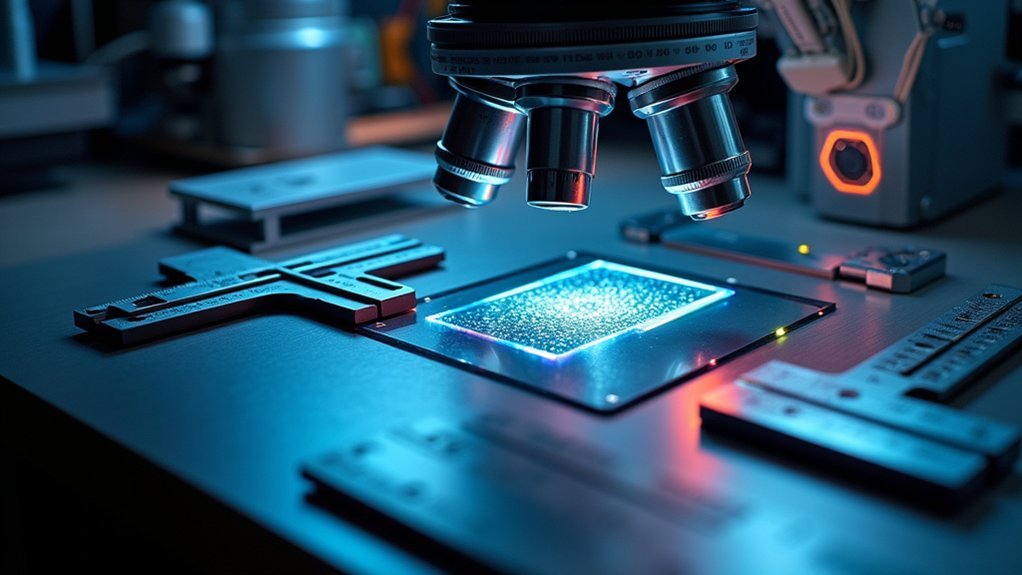
While standard microscopes provide basic lighting, specialized illumination systems equipped with goniometric heads represent a notable advancement for researchers who need precise angular measurements. These systems allow you to control light at exact angles, markedly enhancing observation accuracy during critical analyses.
Telecentric illumination delivers uniform light distribution without perspective distortion—crucial when you’re measuring angles at high magnifications.
You’ll find that adjustable incident illumination at oblique angles dramatically reduces shadowing, revealing fine specimen contours previously hidden from view.
For transparent or challenging materials, multi-angle illumination options improve contrast and detail, making angular assessments considerably more reliable.
Modern LED-based systems not only provide energy efficiency but also maintain specimen integrity during extended measurement sessions by generating minimal heat—a critical advantage when precision matters.
Microscope Stage Adapters for Light Angle Control
Three essential components transform your microscope into a precision angular measurement instrument: stage adapters, goniometric attachments, and tilt platforms. These specialized adapters enable you to position specimens with exacting precision, ensuring ideal light direction during critical observations.
Advanced stage adapters feature adjustable tilting mechanisms that let you reorient transparent or reflective samples to capture the perfect illumination angle. Many incorporate goniometric heads for precise angle measurements, giving you control over the specimen’s orientation relative to your light source.
You’ll find that some premium adapters include built-in illumination systems with variable intensity controls, maximizing your ability to manipulate contrast. This precision particularly enhances polarized light microscopy, where specific light interactions are essential for revealing structural details in your specimens.
Polarization-Based Techniques for Measuring Light Paths
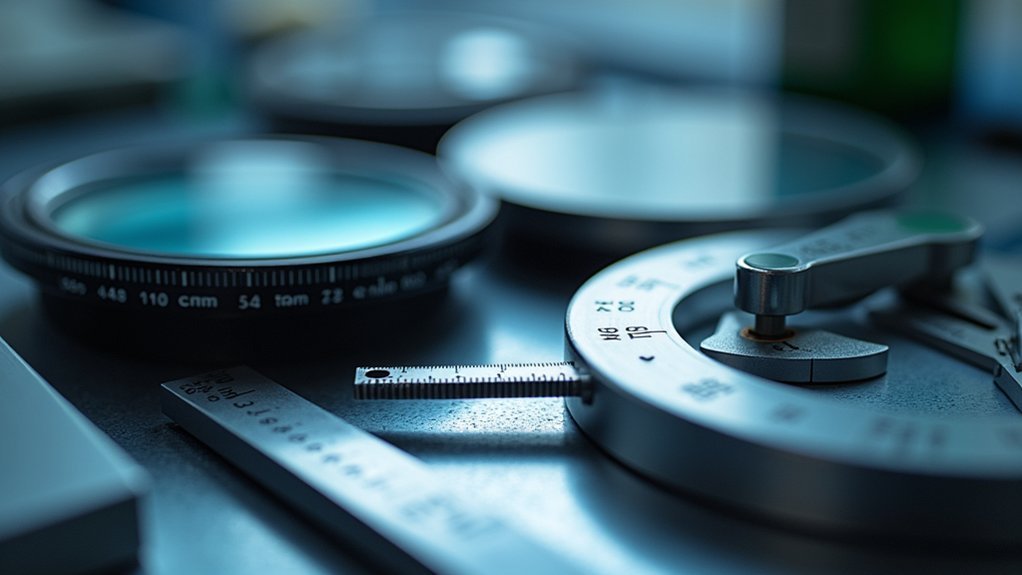
When measuring microscope light angles, you’ll find polarizing filter arrangements offer exceptional precision by isolating specific light vibrations for accurate path analysis.
Compensator plates enhance these measurements by introducing known phase differences that reveal subtle structural details and birefringence properties in your specimens.
Extinction angle measurements, where light transmission drops to minimum levels between crossed polarizers, provide you with quantitative data about crystal orientation and material composition.
Polarizing Filter Arrangements
Since light behaves as both a particle and a wave, polarizing filters offer sophisticated methods for measuring microscope light angles with precision.
By strategically arranging these filters in your optical path, you’ll reveal critical insights into specimen structure that remain invisible under standard illumination.
You can determine material orientation by rotating a polarizer and analyzing how light transmission changes. This technique reveals birefringent properties when light passes through anisotropic samples, giving you valuable structural information.
Paired polarizers positioned at specific angles enhance contrast in transparent specimens that would otherwise appear featureless.
For maximum measurement accuracy, combine polarizing filters with a compensator to quantify phase shifts. This arrangement helps you measure stress patterns in plastics or fibers and characterize complex structures with exceptional detail that conventional microscopy techniques simply can’t match.
Compensator Plate Applications
Compensator plates revolutionize your ability to measure microscope light angles by introducing precise phase shifts to polarized light paths.
When you’re examining birefringent materials, these specialized optical devices quantify the optical path differences between ordinary and extraordinary rays emerging from your specimen.
You’ll find compensators available in various thicknesses, allowing you to select the ideal one for your specific wavelength requirements.
This precision enables you to accurately measure light angles and identify materials based on their unique interference colors under polarized light.
Extinction Angle Measurements
Although often overlooked by novice microscopists, extinction angle measurements provide one of the most powerful methods for determining light paths through birefringent materials.
When you align your sample between crossed polarizers, you’ll notice the specimen darkens at specific rotational positions—this is extinction occurring at precise angles between 0° and 90°.
Your polarized light microscopy setup should include a rotating stage with angular gradations for accurate measurement data. For best results, use compensator plates to enhance contrast at near-extinction positions.
The measured extinction angle reveals the orientation of crystallographic axes relative to polarized light planes, offering critical insights into your specimen’s optical properties.
This technique isn’t just theoretical—it’s essential for identifying mineral compositions in geology and analyzing structural characteristics in biological tissues and synthetic materials.
Calibration Methods for Light Angle Measurement Tools

When you’re working with precision microscopy, proper calibration of your light angle measurement tools becomes vital for reliable results.
You’ll need to use a precision goniometer to assess light angles relative to your microscope’s optical axis, establishing accurate measurement baselines.
Always calibrate under controlled conditions using a known reference angle. Your light source should maintain stable intensity throughout the calibration process to prevent measurement variations.
Don’t overlook the importance of regular calibration to compensate for mechanical wear and environmental factors that cause measurement drift over time.
This routine maintenance guarantees your light angle measurements remain accurate.
Document all calibration results thoroughly.
This documentation isn’t just good practice—it’s critical for reproducibility and validation of measurement accuracy in research and quality control applications.
Advanced Photometric Devices for Microscope Illumination
Advanced photometric devices like Precision Light Angle Meters offer you unparalleled accuracy when measuring microscope illumination angles, featuring multi-lighting systems with telecentric lenses that minimize distortion.
You’ll find Photon Trajectory Analyzers particularly valuable for specialized applications, as they can track light paths through specimens with their high-resolution CMOS sensors.
These sophisticated tools allow you to adjust illumination settings for ideal contrast, making even transparent specimens clearly visible for precise angle assessments.
Precision Light Angle Meters
Among the most sophisticated tools in microscopy illumination, precision light angle meters stand as essential instruments for researchers who need exact measurements of light paths.
These specialized photometric devices guarantee you’ll achieve ideal lighting conditions for your specimens, minimizing distortion and enhancing image quality.
For maximum measurement accuracy, you’ll want to:
- Regularly calibrate your meter against established standards to maintain reliable performance
- Utilize the real-time feedback features to make immediate adjustments to your illumination angles
- Take advantage of data logging capabilities to track lighting conditions across different experiments
Most advanced models offer customizable parameters and multiple illumination settings, making them versatile for various microscopy techniques.
You’ll find these high-resolution sensors particularly valuable when working with specimens requiring precise contrast control.
Photon Trajectory Analyzers
Pioneers in microscopy illumination technology, photon trajectory analyzers represent the cutting edge of light angle measurement.
These advanced photometric devices capture how light interacts with your specimens, providing critical insights for improving microscopy results.
You’ll benefit from their high-resolution sensors that precisely measure incident and reflected light angles, helping you minimize optical aberrations while enhancing image clarity and contrast.
Many models offer real-time visualization software, allowing you to adjust illumination settings on the fly for ideal specimen observation.
Choosing the Right Angle Measurement Tool for Your Specimen Type
When examining microscopic structures, why settle for imprecise angle measurements that can compromise your research? Your angle measurement tool selection should align with your specimen’s unique characteristics to guarantee accuracy.
Precise angle measurement isn’t optional—it’s the cornerstone of credible microscopic research.
For best results, consider these key factors:
- Transparency level – Transparent samples benefit from phase contrast microscopy to enhance visibility of angles and boundaries.
- Geometric complexity – Specimens with intricate geometries require digital X-Y micrometers with 0.01mm resolution.
- Surface reflectivity – Adjustable variable intensity lighting minimizes shadows and improves angle clarity.
For maximum precision, pair your chosen tools with a goniometric head featuring calibrated scales.
When dealing with complex specimens, a telecentric lens will greatly reduce distortion while improving edge visibility—critical for accurate angular measurements.
Practical Applications of Light Angle Measurements in Research
Because light angle manipulation directly impacts image quality, precise measurements have become essential across various research disciplines.
When light microscopes are used in cell biology, controlling illumination angles enables you to visualize transparent structures with enhanced contrast, revealing details that would otherwise remain invisible.
In materials science, measuring light angles helps analyze birefringence properties, providing vital insights into structural characteristics. This capability proves especially valuable for high resolution imaging of crystalline structures and polymers.
For industrial applications, consistent light angle measurements using telecentric lenses guarantee quality control by eliminating perspective distortions. You’ll achieve more reliable measurements regardless of specimen positioning or operator experience.
Automated measurement systems further standardize this process, assuring reproducible results and allowing you to focus on analysis rather than technical adjustments.
Frequently Asked Questions
What Unit of Measurement Is Used to Measure a Specimen Viewed With a Light Microscope?
You’ll primarily use micrometers (µm) to measure specimens under a light microscope. These are one-millionth of a meter, allowing you to accurately quantify tiny cellular structures that aren’t visible to the naked eye.
What Two Pieces of Equipment Are Used to Measure a Cell Under a Light Microscope?
To measure a cell under a light microscope, you’ll need an eyepiece reticle (ocular micrometer) and a stage micrometer slide. Together, they allow you to calibrate and accurately measure cellular dimensions in microns.
What Is an Instrument That Uses Visible Light and Lenses to Magnify a Specimen?
You’re asking about an instrument that uses visible light and lenses for magnification. That’s a light microscope, which allows you to view tiny specimens at 40x to 1000x magnification that aren’t visible to the naked eye.
What Two Measuring Devices Are Needed to Measure With a Microscope?
You’ll need a calibrated eyepiece reticule to view measurements directly through the microscope and a goniometer for precise angular measurements. These tools work together to help you accurately determine specimen dimensions and orientations.
In Summary
You’ll find that precise light angle measurements greatly enhance your microscopy results. Whether you choose goniometers, digital solutions, or advanced photometric devices, the right tool depends on your specimen and research goals. Don’t underestimate calibration’s importance in maintaining accuracy. By applying these specialized tools correctly, you’ll capture more detailed images and extract better data from your microscopic observations.

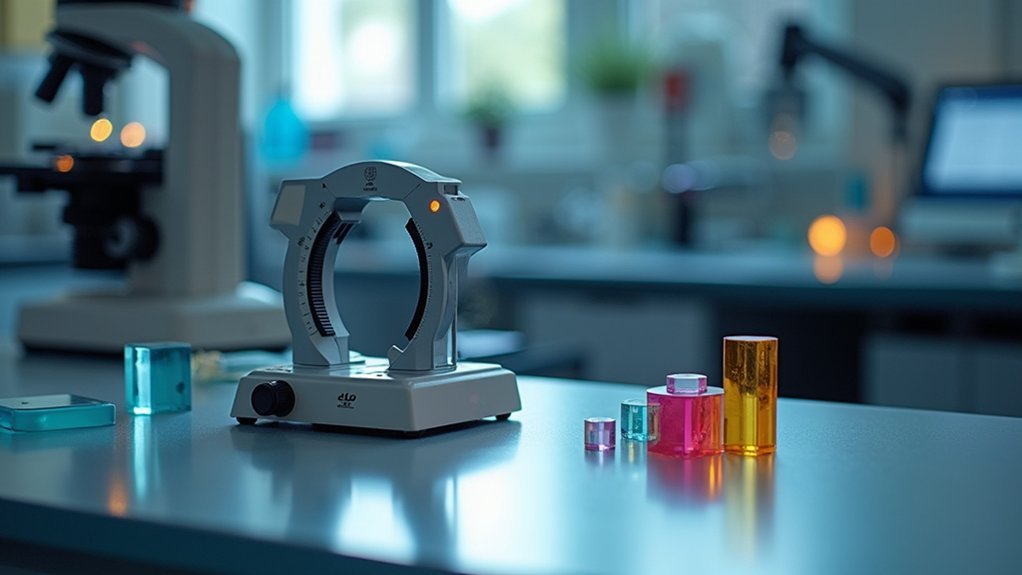



Leave a Reply